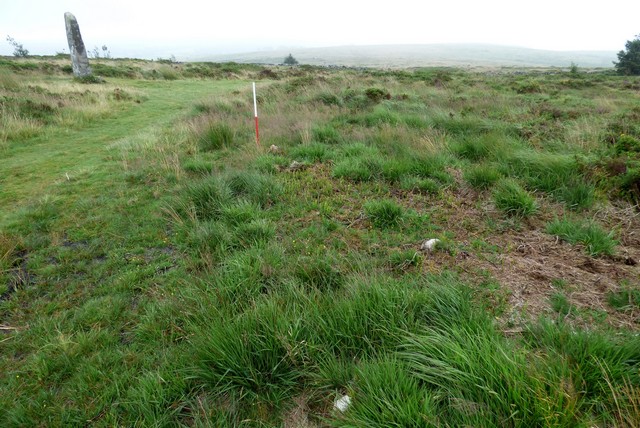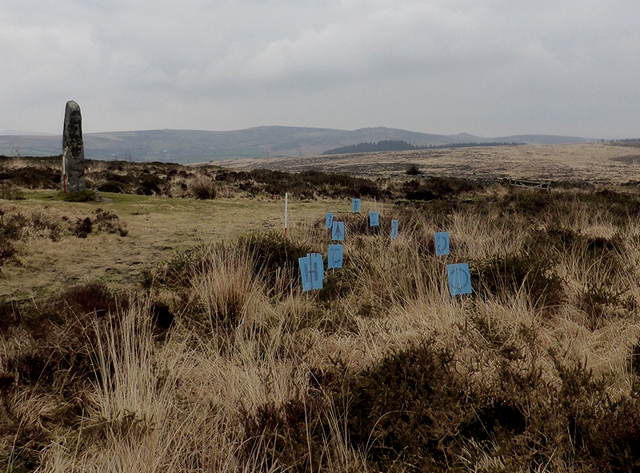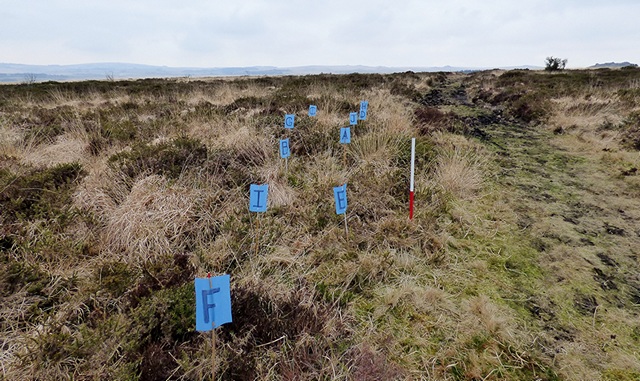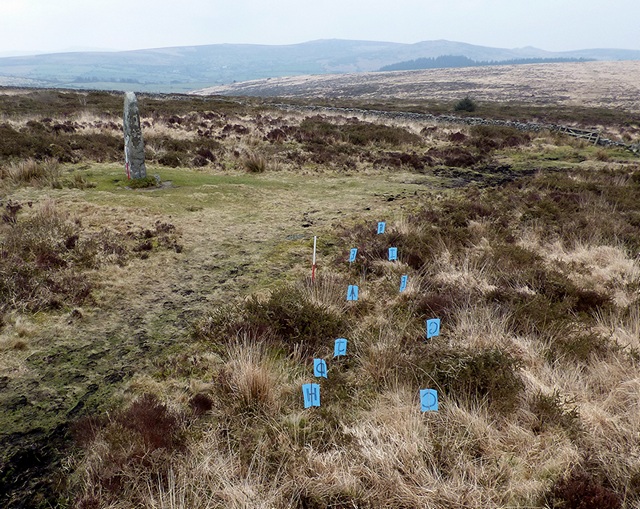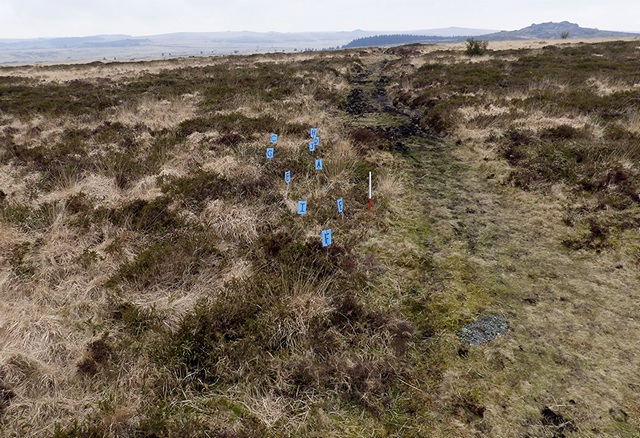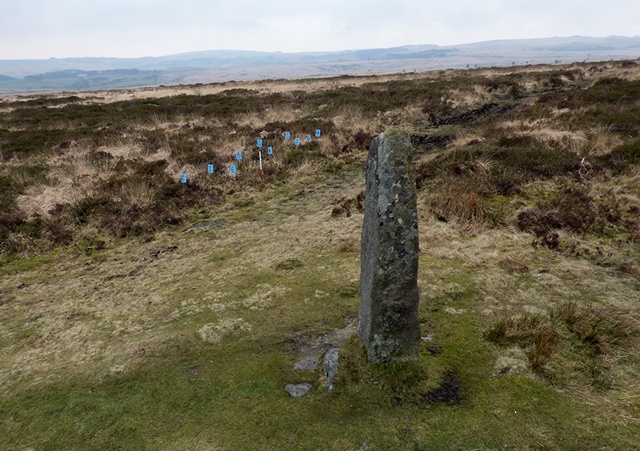Looking east along the row (Scale 1m).
A double stone row measuring 17.8m long, including at least 15 small-sized stones situated on a gently sloping south facing terrace. The row is orientated ESE to WNW, stands close to another stone row and points towards a distant restricted glimpse of the sea.
Location
| England Devon Dartmoor SX 65208 75393 Lat 50.56263441 Long -3.90454199 |
Map showing the location of Laughter Tor 2 stone row.
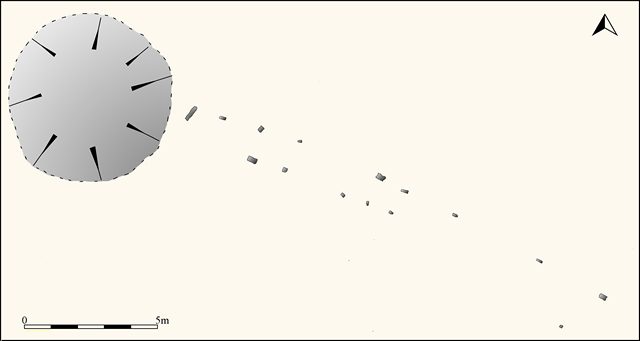
Plan of Laughter Tor 2 stone row (Source: Survey at 1:100 by Sandy Gerrard).
Characteristics
| Type: Double | Length: 17.8m |
| No. of stones: 15 | Size of stones: Small only |
| Orientation: 113° | Altitude: 393m |
| Upper end: Cairn? | Lower end: – |
| Straight (Yes or No) : No | Sea View: Yes |
| Context: Stone alignment and prehistoric field system | |
| Notes: Cairn at upper end described by Woolner who discovered the row has not been confirmed by later work. A very slight mound at the upper end may be the cairn described by Woolner, but it may represent a build-up of vegetation [19.08.2020]. Whilst most of the row had been cleared of vegetation at the time of the 2020 survey the possible mound at the western end and the three stones at the end remained hidden from sight. | |
Other Information
| Public Access: Yes |
| Land Status: National Park |
| Scheduled Ancient Monument: Yes |
Identification
Category: Plausible. No substantiated doubts have been expressed regarding this row.
Typology
This stone row is of Type D4. Information on this form of stone row and other rows of this type is available here.
Individual Stones
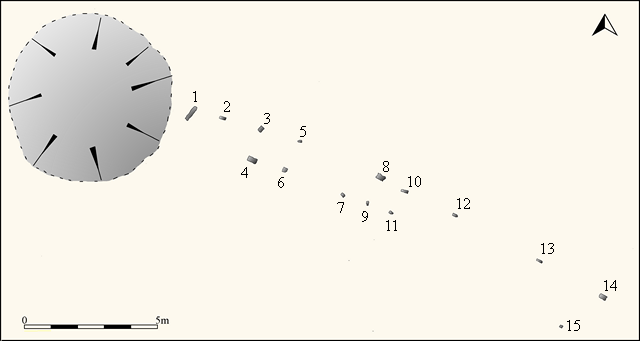
Plan of Laughter Tor 2 stone row showing position of numbered stones.

Stone 1 measures 0.60m long, 0.14m wide, stands up to 0.10m high and is orientated at 37°. View from east (Scale 1m).
Stone 2 measures 0.25m long, 0.10m wide, is covered in turf and is orientated at 115°.
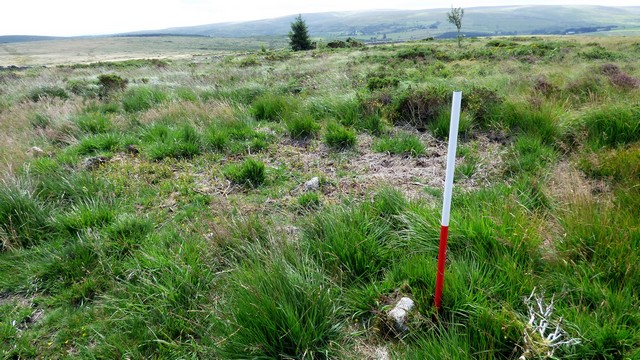
Stone 3 measures 0.21m long, 0.17m wide, stands up to 0.21m high and is orientated at 43°. View from north west (Scale 1m).
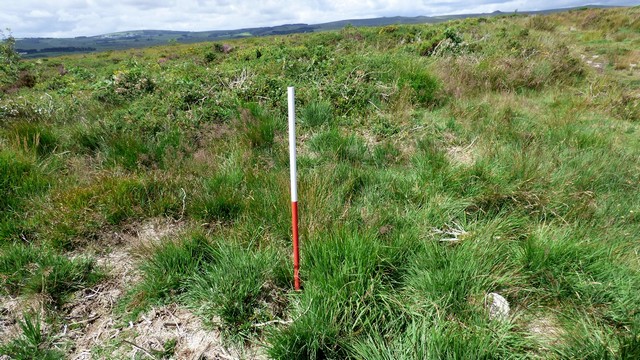
Stone 4 immediately left of the ranging rod measures 0.37m long, 0.18m wide, stands up to 0.19m high and is orientated at 115. View from east (Scale 1m).
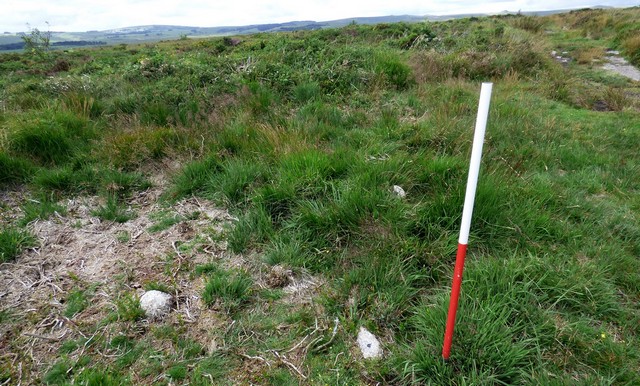
Stone 5 left of the ranging rod measures 0.16m long, 0.09m wide, stands up to 0.08m high and is orientated at 90°. View from east (Scale 1m).
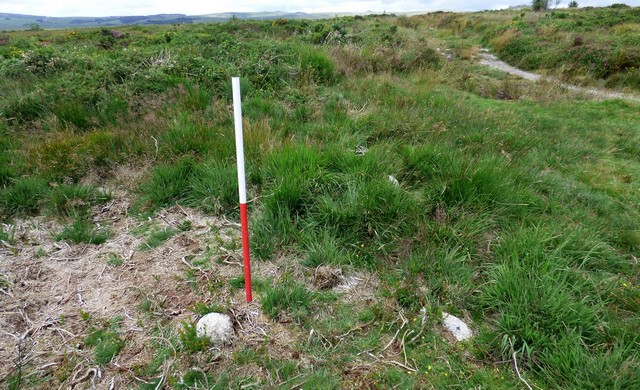
Stone 6 measures 0.17m long, 0.17m wide and stands up to 0.12m high. View from east (Scale 1m).
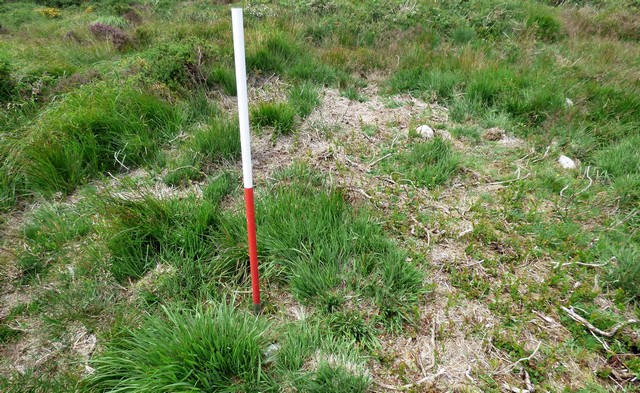
Stone 7 in front of the ranging rod measures 0.16m long, 0.10m wide, stands up to 0.05m high and is orientated at 142°. View from south (Scale 1m).
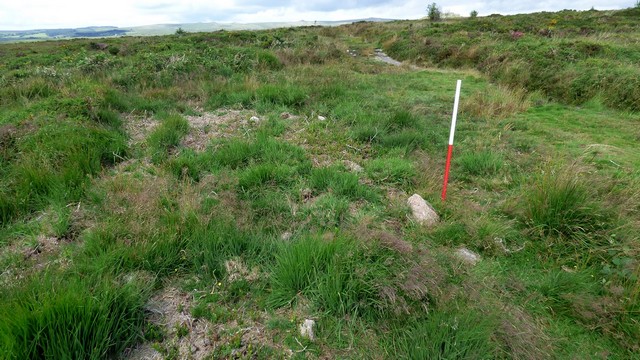
Stone 8 measures 0.33m long, 0.20m wide, stands up to 0.26m high and is orientated at 121°. View from east (Scale 1m).
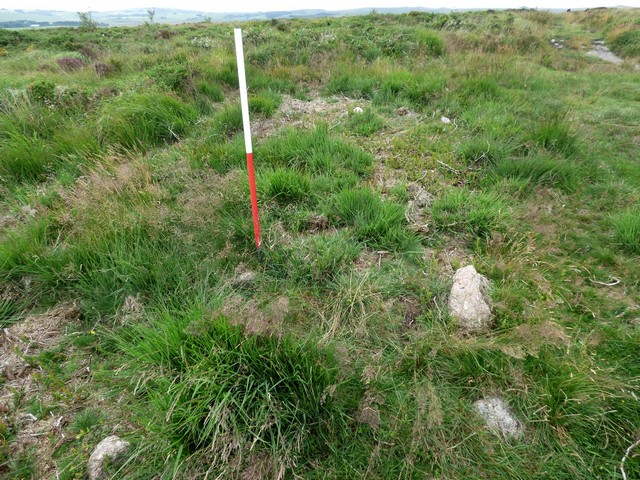
Stone 9 in front of ranging rod measures 0.16m long, 0.10m wide, stands up to 0.10m high and is orientated at 175°. View from east (Scale 1m).

Stone 10 in front of the ranging rod measures 0.28m long, 0.10m wide, stands up to 0.06m high and is orientated at 118°. View from east (Scale 1m).

Stone 11 measures 0.16m long, 0.10m wide, stands up to 0.10m high and is orientated at 125°. View from east (Scale 1m).

Stone 12 measures 0.20m long, 0.09m wide, stands up to 0.02m high and is orientated at 116°. View from east (Scale 1m).
Stone 13 is covered in vegetation, measures 0.23m long, 0.08m wide, stands up to 0.05m high and is orientated at 117°.
Stone 14 is covered in vegetation, measures 0.28m long, 0.18m wide and is orientated at 120°.
Stone 15 is covered in vegetation, measures 0.12m long, 0.10m wide and is orientated at 120°.
Photographs (27th July 2020)
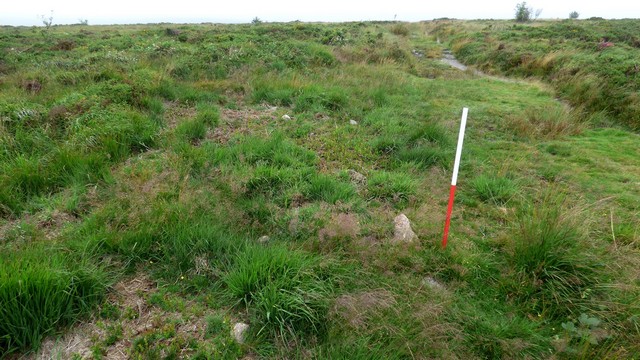
Looking west along the row (Scale 1m).
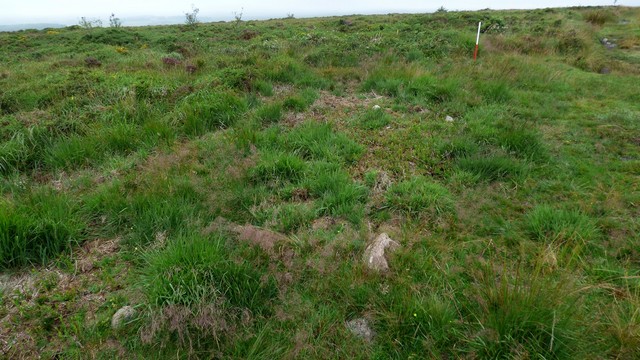
The western length of the row. View from east (Scale 1m).
Sea View
Laughter Tor 2 stone row has a very precise and definable visual link with the sea. The row itself points directly at a “pin-prick” sized glimpse of the sea. The precision of this relationship strongly suggests that the site was chosen to incorporate this element of the landscape and provides further evidence for the intricate connection of rows with the landscape in which they were erected. The Heywhatsthat rendering of the sea view is available here.

Only a tiny glimpse of the sea is available from the stone row.
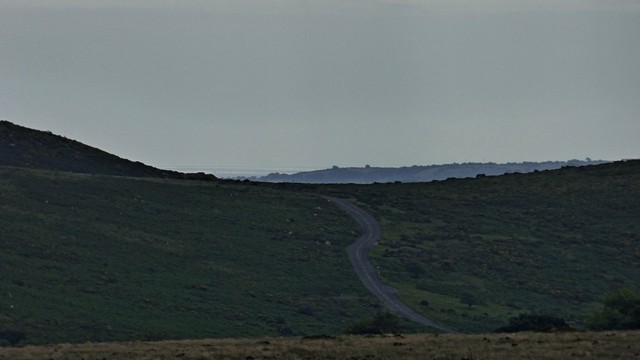
The sea view from Laughter Tor 2.
Photographs (22nd February 2018)
At this time the row was hidden by dense vegetation

Tiny stone barely visible within the heather forms part of the Laughter Tor 2 stone row.
Looking south east along the row. The postions of the stones are marked by blue flags. The large stone stands at the upper end of Laughter Tor 1 (Scale 1m).
Looking north west along the row. The postions of the stones are marked by blue flags. The large slab in the foreground may have formed part of the row or is more likely to be natural (Scale 1m).
The large pillar at the upper end of Laughter Tor 1 with Laughter Tor 2 beyond denoted by blue flags. View from north east (Scales 1m).
View from east showing the relative positions of Laughter Tor 1 (the large standing stone) and Laughter Tor 2 marked with blue flags (Scale 1m).
Looking north west along the row. The position of the row provides extensive views of the northern moor.
View from above and north west of the row and standing stone at the top of Laughter Tor 1 (Scales 1m).
View from above and the south east (Scale 1m).
View from above and east showing the relative position of the two rows at Laughter Tor (Scale 1m).
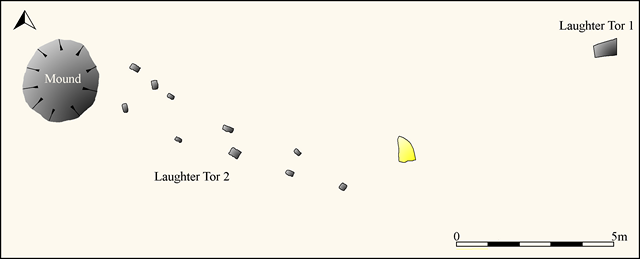
Original plan of the row prior to removal of vegetation (Source: Survey by Sandy Gerrard and Janet Daynes in 2018)
Access Information
Car parking is available at SX 64577 74591. From here take the bridleway north westward for about 900m. Take the path towards the tall stone at the upper end of the row. The Laughter Tor 2 row is situated very close to the upper end of Laughter Tor 1 row and depending on vegetation conditions may be visible.
Acknowledgements
Janet Daynes helped with the 2018 survey and recording.
Online Resources
Megalithic Portal PastScape Historic Environment Record
Prehistoric Monuments of Dartmoor Prehistoric Dartmoor Walks
Other References
Butler, J., 1991, Dartmoor Atlas of Antiquities – Vol. 2 – The North, Devon Books Exeter, pgs.58-59.
Timeline
VISITED:- 22nd February 2018 and 27th July 2020
FIRST PUBLISHED:- 24th January 2016
LAST UPDATED:- 27th February 2018

